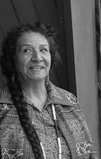Lucy Covington facts for kids
Quick facts for kids
Lucy Covington
|
|
|---|---|
 |
|
| Born | November 24, 1910 |
| Died | September 20, 1982 (aged 71) Nespelem, Washington
|
| Nationality | Colville |
| Other names | Lucy Friedlander Covington |
| Occupation | Native American tribal leader and political activist |
| Relatives | Paulette Jordan, Chief Moses (Grandfather) |
Lucy Friedlander Covington (November 24, 1910 – September 20, 1982) was an important Native American leader and activist. She was a member of the Colville tribe, which has a special land area called a reservation in north-eastern Washington state. Lucy Covington was the granddaughter of the last Colville chief, Chief Moses, who was recognized by the tribe. Her parents were Nellie Moses and Louis T. Friedlander Sr.
Contents
Fighting for Her Tribe's Land
In the 1950s, the government had a plan called "termination policy" for Native American tribes. Officials said this plan would help Native Americans become "free." But in reality, termination meant tribes would lose their land. Losing land was a huge threat to the Colville people and their way of life.
Lucy Covington saw that her tribe was in danger. She believed that tribal land was the most important thing for Native Americans. She decided to fight against the government's plan to terminate the Colville tribe. She wanted her tribe to have "self-determination," meaning they could make their own choices.
Protecting Tribal Rights
At first, many people in her tribe thought termination might be a good idea. Lucy had been on the tribal council since 1956, and some other members supported the government's plan. But Lucy did not give up. She worked very hard to protect her tribe's lands.
Lucy lived on a ranch and raised cattle. She sold some of her cattle to get money. She used this money to travel many times to Washington, D.C. There, she fought against Senator Henry M. Jackson of Washington, who was trying to pass the termination bill.
Building Support for Her Cause
Lucy Covington used clever ways to get people to support her. She had a strong and friendly personality. She organized younger members of the tribe to help her. She even helped start a Colville newspaper called Our Heritage. This newspaper helped tell people about her fight and also celebrated Native American culture.
Whenever a tribal council member tried to present a termination plan to Congress, Lucy protested. In 1968, she created her own plan to run in the tribal election, promising to stop termination. She asked Menominee leader Jim White to speak to her tribe. He explained the real problems that termination would cause. After all her hard work, the people who wanted to stop termination won most of the seats in the election.
Lucy Covington successfully changed her tribe's mind. The new council stopped the termination bill for good in 1971. This was a big victory! It showed that tribes could use their "sovereignty" (their right to govern themselves) to change decisions made by the government. Because of Lucy's strong will and actions, the Colville tribe kept their land and their right to govern themselves.
A Legacy of Leadership
After the fight against termination, Lucy Covington continued to work hard. She protected tribal rights and resources. She helped develop services for tribe members and worked to make the reservation better for everyone. She also helped different tribes work together.
Lucy Covington was a great example of Native American self-determination. She helped start a movement that changed U.S. government policy. Instead of trying to terminate tribes, the government began to support their independence and right to govern themselves.
Her Final Years
In 1982, Lucy Covington passed away at the age of seventy-one. She died from a lung condition called pulmonary fibrosis.
The Lucy Covington Center
In 2015, Eastern Washington University built the Lucy Covington Center. This center honors her powerful activism and her memory. It is a place to teach and inspire young Native Americans to become leaders, just like Lucy Covington.

